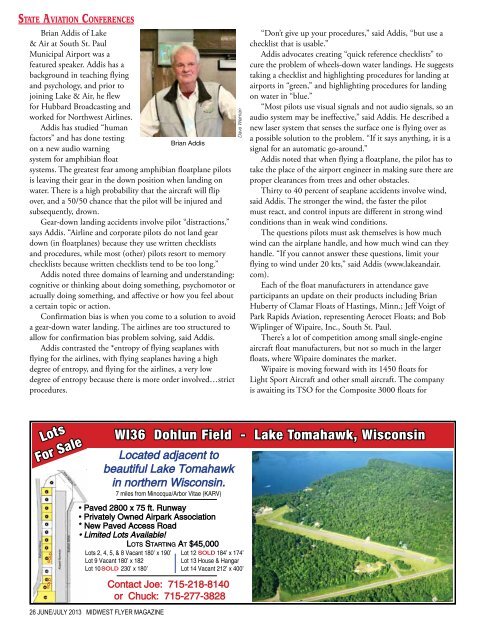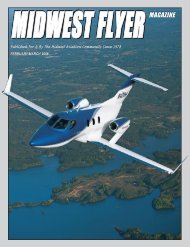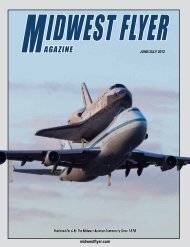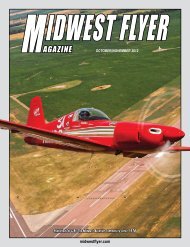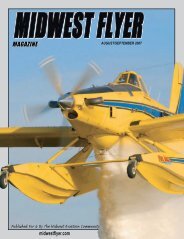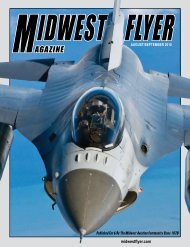Create successful ePaper yourself
Turn your PDF publications into a flip-book with our unique Google optimized e-Paper software.
State Aviation Conferences<br />
Brian Addis of Lake<br />
& Air at South St. Paul<br />
Municipal Airport was a<br />
featured speaker. Addis has a<br />
background in teaching flying<br />
and psychology, and prior to<br />
joining Lake & Air, he flew<br />
for Hubbard Broadcasting and<br />
worked for Northwest Airlines.<br />
Addis has studied “human<br />
factors” and has done testing<br />
Brian Addis<br />
on a new audio warning<br />
system for amphibian float<br />
systems. The greatest fear among amphibian floatplane pilots<br />
is leaving their gear in the down position when landing on<br />
water. There is a high probability that the aircraft will flip<br />
over, and a 50/50 chance that the pilot will be injured and<br />
subsequently, drown.<br />
Gear-down landing accidents involve pilot “distractions,”<br />
says Addis. “Airline and corporate pilots do not land gear<br />
down (in floatplanes) because they use written checklists<br />
and procedures, while most (other) pilots resort to memory<br />
checklists because written checklists tend to be too long.”<br />
Addis noted three domains of learning and understanding:<br />
cognitive or thinking about doing something, psychomotor or<br />
actually doing something, and affective or how you feel about<br />
a certain topic or action.<br />
Confirmation bias is when you come to a solution to avoid<br />
a gear-down water landing. The airlines are too structured to<br />
allow for confirmation bias problem solving, said Addis.<br />
Addis contrasted the *entropy of flying seaplanes with<br />
flying for the airlines, with flying seaplanes having a high<br />
degree of entropy, and flying for the airlines, a very low<br />
degree of entropy because there is more order involved…strict<br />
procedures.<br />
Dave Weiman<br />
“Don’t give up your procedures,” said Addis, “but use a<br />
checklist that is usable.”<br />
Addis advocates creating “quick reference checklists” to<br />
cure the problem of wheels-down water landings. He suggests<br />
taking a checklist and highlighting procedures for landing at<br />
airports in “green,” and highlighting procedures for landing<br />
on water in “blue.”<br />
“Most pilots use visual signals and not audio signals, so an<br />
audio system may be ineffective,” said Addis. He described a<br />
new laser system that senses the surface one is flying over as<br />
a possible solution to the problem. “If it says anything, it is a<br />
signal for an automatic go-around.”<br />
Addis noted that when flying a floatplane, the pilot has to<br />
take the place of the airport engineer in making sure there are<br />
proper clearances from trees and other obstacles.<br />
Thirty to 40 percent of seaplane accidents involve wind,<br />
said Addis. The stronger the wind, the faster the pilot<br />
must react, and control inputs are different in strong wind<br />
conditions than in weak wind conditions.<br />
The questions pilots must ask themselves is how much<br />
wind can the airplane handle, and how much wind can they<br />
handle. “If you cannot answer these questions, limit your<br />
flying to wind under 20 kts,” said Addis (www.lakeandair.<br />
com).<br />
Each of the float manufacturers in attendance gave<br />
participants an update on their products including Brian<br />
Huberty of Clamar Floats of Hastings, Minn.; Jeff Voigt of<br />
Park Rapids Aviation, representing Aerocet Floats; and Bob<br />
Wiplinger of Wipaire, Inc., South St. Paul.<br />
There’s a lot of competition among small single-engine<br />
aircraft float manufacturers, but not so much in the larger<br />
floats, where Wipaire dominates the market.<br />
Wipaire is moving forward with its 1450 floats for<br />
Light Sport Aircraft and other small aircraft. The company<br />
is awaiting its TSO for the Composite 3000 floats for<br />
Lots<br />
For Sale<br />
SOLD<br />
SOLD<br />
WI36 Dohlun Field - Lake Tomahawk, Wisconsin<br />
Located adjacent to<br />
beautiful Lake Tomahawk<br />
in northern Wisconsin.<br />
7 miles from Minocqua/Arbor Vitae (KARV)<br />
• Paved 2800 x 75 ft. Runway<br />
• Privately Owned Airpark Association<br />
* New Paved Access Road<br />
• Limited Lots Available!<br />
Lots starting at $45,000<br />
Lots 2, 4, 5, & 8 Vacant 180’ x 190’ Lot 12 SOLD Vacant 184’ x 174’<br />
Lot 9 Vacant 180’ x 182<br />
Lot 13 House & Hangar<br />
Lot 10 SOLD Vacant 230’ x 180’<br />
Lot 14 Vacant 212’ x 400’<br />
Contact Joe: 715-218-8140<br />
or Chuck: 715-277-3828<br />
26 JUNE/JULY 2013 MIDWEST FLYER MAGAZINE<br />
Lake Tomahawk March2012.indd 1<br />
3/8/12 6:37 AM


